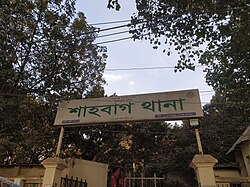Shahbagh
শাহবাগ থানা | |
|---|---|
 Shahabagh Thana (police station) Main Entrance | |
 | |
| Coordinates: 23°44.3′N 90°23.75′E / 23.7383°N 90.39583°E | |
| Municipality | Dhaka |
| Area | |
| • Total | 17.4 km2 (6.7 sq mi) |
| Population (2011)[1] | |
| • Total | 68,140 |
| • Density | 3,900/km2 (10,000/sq mi) |
| Website | www |

Shahbagh (also Shahbaugh or Shahbag, Bengali: শাহবাগ, romanized: Shāhbāg, IPA: [ˈʃaːbaːɣ]) is a major neighbourhood and a police precinct or thana in Dhaka, the capital and largest city of Bangladesh. It is also a major public transport hub.[2] It is a junction between two contrasting sections of the city—Old Dhaka and New Dhaka—which lie, respectively, to its south and north. Developed in the 17th century during Mughal rule in Bengal, when Old Dhaka was the provincial capital and a centre of the flourishing muslin industry, it came to neglect and decay in early 19th century. In the mid-19th century, the Shahbagh area was developed as New Dhaka became a provincial centre of the British Raj, ending a century of decline brought on by the passing of Mughal rule.
Shahbagh is the location of the nation's leading educational and public institutions, including the University of Dhaka, the oldest and largest public university in Bangladesh, Dhaka Medical College, the largest medical college in the country, Bangabandhu Sheikh Mujib Medical University (BSMMU), and the Bangladesh University of Engineering and Technology, the largest public university for technological studies in the country. Shahbagh hosts many street markets and bazaars. Since Bangladesh achieved independence in 1971, the Shahbagh area has become a venue for celebrating major festivals, such as the Bengali New Year and Basanta Utsab.
Shahbagh's numerous ponds, palaces and gardens have inspired the work of writers, singers, and poets. With Dhaka University at its centre, the thana has been the origin of major political movements in the nation's 20th century history, including the All India Muslim Education Conference in 1905, which led to the All India Muslim League. In 1947, to both the partition of India and the creation of Pakistan; the Bengali Language Movement in 1952, which led to the recognition of Bengali as an official language of Pakistan; and the Six point movement in 1966, which led to the nation's independence. It was here, on 7 March 1971, that Sheikh Mujibur Rahman delivered a historic speech calling for the independence of Bangladesh from Pakistan, and here too, later that year, that the Pakistani Army surrendered in the Liberation War of Bangladesh. The area has since become a staging ground for protests by students and other groups. It was the site of public protests by around 30,000 civilians on 8 February 2013, against a lenient ruling against war criminals.[3][4][5]
- ^ Bangladesh Bureau of Statistics (2011). "Population & Housing Census" (PDF). Bangladesh Government. Archived from the original (PDF) on 3 September 2017. Retrieved 17 April 2015.
- ^ Nawazish, Mohammed (17 September 2003). "Bus Menace In Dhaka Streets". The Bangladesh Observer. Archived from the original on 21 March 2005. Retrieved 5 April 2007.
- ^ Khan, Mubin S. (2 August 2002). "Eight days that shook the campus". Weekly Holiday. Archived from the original on 13 February 2005. Retrieved 12 April 2007.
- ^ "DU students on rampage: Student injured in road accident". The Independent. Dhaka. 10 May 2006. Archived from the original on 14 July 2006. Retrieved 12 April 2007.
- ^ "Environmentalists for steps to limit green house gas, global warming". New Age. Dhaka. 12 November 2006. Archived from the original on 28 September 2007. Retrieved 12 April 2007.
© MMXXIII Rich X Search. We shall prevail. All rights reserved. Rich X Search
